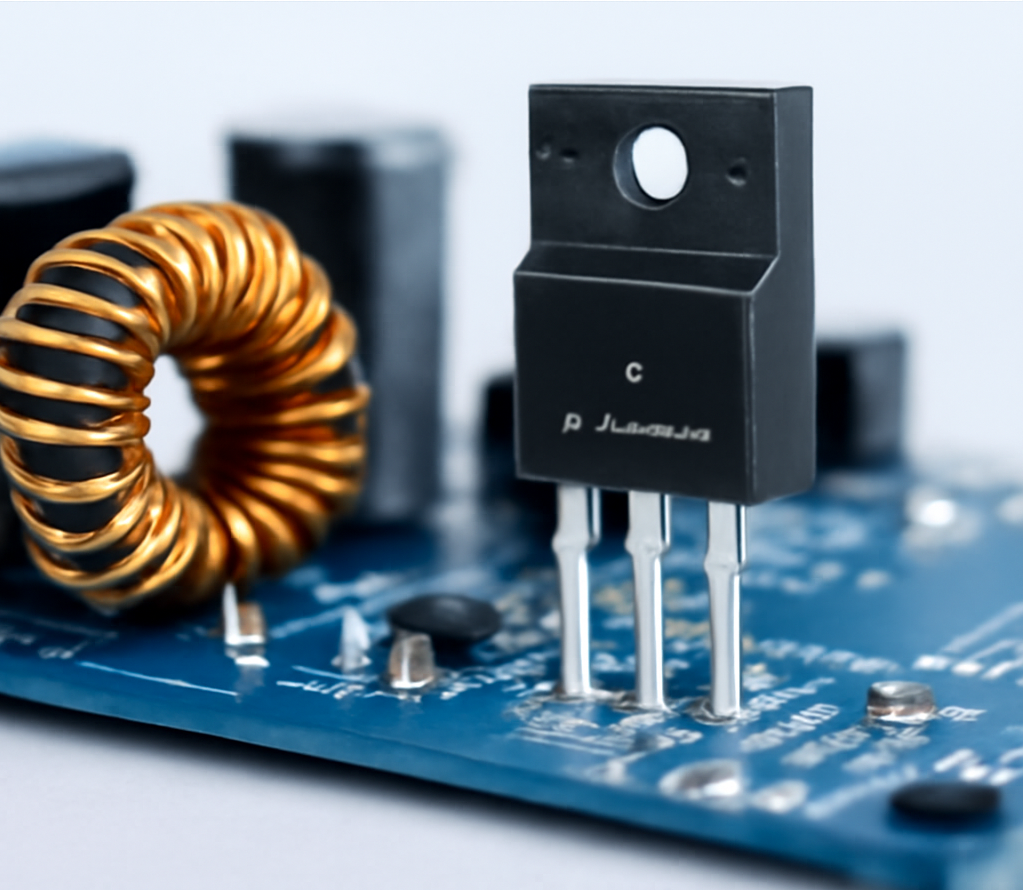این مقاله بهطور مفصل به کاربردهای دیودهای بازیابی فوقالعاده سریع در منابع تغذیه سوئیچینگ، مبدلهای DC-DC و درایوهای موتور میپردازد و همچنین روند توسعه آینده آنها را بررسی میکند.

I. مقدمهای بر دیودهای بازیابی فوقالعاده سریع
دیودهای بازیابی فوقالعاده سریع (UFRD) دستگاههای نیمرسانا هستند که بهطور خاص برای کاربردهای با فرکانس بالا طراحی شدهاند. این دیودها میتوانند به سرعت از حالت هدایت به حالت غیرهدایت بازگردند و بدین ترتیب اتلافات سوئیچینگ را کاهش دهند. این دیودها نقش بحرانی در ماژولهای توان، منابع تغذیه سوئیچینگ (SMPS) و دیگر سیستمهای الکترونیک قدرت با فرکانس بالا ایفا میکنند، بهویژه در سناریوهایی با جریان بالا و سوئیچینگ سریع.
II. اصل کارکرد دیودهای بازیابی فوقالعاده سریع
اصل کار دیودهای بازیابی فوقالعاده سریع بر اساس توانایی آنها در بازگشت از حالت هدایت به حالت بلوکهکننده در مدت زمان بسیار کوتاهی استوار است. وقتی دیود در حال هدایت است، جریان از آند به سمت کاتد جریان مییابد و باری درون دیود ذخیره میشود. هنگام قطع جریان، دیود بازیابی فوقالعاده سریع به سرعت این بار ذخیرهشده را از بین میبرد و از جریان یافتن جریان معکوس در هنگام خاموش شدن دیود جلوگیری میکند.
III. مزایای دیودهای بازیابی فوقالعاده سریع
زمان بازیابی معکوس کم: دیودهای بازیابی فوقالعاده سریع معمولاً زمان بازیابی معکوسی در محدوده نانوثانیه دارند که اتلاف سوئیچینگ را بهطور قابل توجهی کاهش میدهد و کارایی تبدیل انرژی را افزایش میدهد.
تحمل ولتاژ بالا: این دیودها میتوانند ولتاژ معکوس بالایی را تحمل کنند و این ویژگی آنها را در کاربردهای با ولتاژ بالا مانند منابع تغذیه با فرکانس بالا و مبدلهای DC-DC مناسب میکند.
تبدیل انرژی با کارایی بالا: به دلیل داشتن بار بازیابی معکوس کم، دیودهای بازیابی فوقالعاده سریع تبدیل انرژی کارآمدتری فراهم میکنند و اتلاف حرارتی را کاهش میدهند.
IV. سناریوهای کاربردی: منابع تغذیه سوئیچینگ و سیستمهای محرکه موتور
منبع تغذیه سوئیچینگ (SMPS): دیودهای بازیابی فوقالعاده سریع بهطور گستردهای در SMPS استفاده میشوند، بهویژه در فرآیندهای سوئیچینگ با فرکانس بالا، که به کاهش تلفات سوئیچینگ و افزایش کارایی سیستم کمک میکنند.
سیستمهای محرکه موتور: در مدارهای محرکه موتور، دیودهای بازیابی فوقالعاده سریع با فشار قدرت سریع جریان معکوس، سرعت پاسخدهی و پایداری سیستم را بهبود میبخشند.
کانورترهای DC با فرکانس بالا: در کانورترهای DC با فرکانس بالا (کانورترهای DC-DC)، قابلیتهای سوئیچینگ سریع دیودهای بازیابی فوقالعاده سریع دقت و کارایی تبدیل انرژی را بهطور قابلتوجهی افزایش میدهند.
نکات انتخاب دیودهای بازیابی فوقالعاده سریع
هنگام انتخاب دیودهای بازیابی فوقالعاده سریع، مهندسان باید پارامترهای زیر را در نظر بگیرند:
زمان بازیابی معکوس (Trr): دیودهایی با زمان بازیابی معکوس کوتاهتر را انتخاب کنید تا کارایی سیستم بهبود یابد.
جریان اوج مستقیم (IF): اطمینان حاصل کنید که حداکثر رتبهبندی جریان مستقیم دیود با الزامات جریان سیستم مطابقت دارد.
ولتاژ نامی: اطمینان حاصل کنید که ولتاژ معکوس رتبهبندی شده دیود از حداکثر ولتاژ معکوس در سیستم بیشتر است.
نوع بستهبندی: بستهبندی مناسب را بر اساس کاربرد انتخاب کنید، مانند TO-220، TO-247 یا SMD، تا پراکندگی مناسب گرما ایجاد شود.
VI. روندهای آینده
با افزایش تقاضا برای کارایی بالاتر در تبدیل توان، دیودهای بازیابی فوقالعاده سریع در حال پیشرفت به سمت کاهش بار بازیابی معکوس، پاسخگویی سریعتر در فرکانس و طراحیهای ادغامشده هستند. علاوهبراین، ظهور مواد جدیدی مانند نیترید گالیوم (GaN) و کاربید سیلیسیم (SiC) در حال ایجاد یک انقلاب در فناوری دیودهای بازیابی فوقالعاده سریع است و عملکرد آنها را در تبدیل کارا و کاربردهای با ولتاژ بالا بهبود میدهد.
دیودهای بازیابی فوقالعاده سریع | حفاظت منبع تغذیه فرکانس بالا | مدارهای درایو موتور